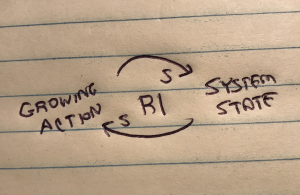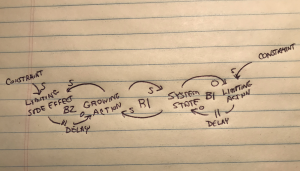This post is about you, as a business owner, finding urgency to pay attention to how you are growing your business and what is either already limiting, or about the limit that growth. If you don’t pay attention, I can promise you, even if you believe your team is exerting maximum effort, you will see revenues fall off.
Why do I say this? A universal truth is – what starts to grow will stop growing without direct intervention. In your own business, you have growth (e.g., initial revenue growth, new product growth, organization size growth, growth in processes and systems) that will start to grow slower and/or falter completely without your intervention to make good decisions. The underlying principle at work comes from systems thinking (see “Read More Related Posts” at the bottom of this article). The systems thinking archetype called “Limits to Growth” was built to illustrate the basic truth that – Initial growth in the system will eventually start to fall off or will be limited due to either (a) a growth constraint or (b) an effort constraint created by the growth itself.
The “limits to growth” archetype

Figure 1.
The “Limits to Growth” archetype starts with the basic growth effort and results you see in Figure 1. The growing action reinforces (or grows) the system state which then reinforces the growing action. This loop leads one to believe that as long as you continue to apply effort (growing actions), the system state would continue to grow (e.g., if you do marketing and get some leads, do MORE marketing and get MORE leads!). However, we all know about laws of diminishing returns and that is based on this very limits to growth model we will discuss. There are always limits or side effects which disrupt growth even when more and more effort is applied. We want to look at how your leadership, meaning how you collaborate with your team to identify, anticipate, avoid, and/or eliminate the limits and side effects, can maximize your growth opportunities.
Constraints that limit the growth
There are two types of constraints that create limiting, or balancing forces that are going to affect the system. Figure 2 illustrates the occurrence of one or more limitations on how much growth is possible in the system state.

Figure 2.
What can limit the growth potential? Here is a big example – population growth! There are concerns about the “limits” (e.g., amount of resources, space, etc.) available to sustain populations in specific countries and of course, in total.
Or another example – why do some violin players excel why others don’t? It could be practice related (effort), but for those who all practice diligently there is simply a limit for some in terms of physical ability or aptitude.
Here is a business example. When I worked in the publishing world, a sister group in our company launched a new technology magazine about Windows NT just as Microsoft launched this long awaited server operating system. As more companies adopted Windows NT (and more interest from system administrators), paid subscription revenue went through the roof for this publication. The group spent money on marketing, and the more they spent to reach these new system admins, the more subscriptions came rolling in. However, within a few years, subscription counts started falling. The group spent more on marketing, but that did not help and was just a waste of money. Why? There were actually three limiting factors that started to kick in, and quite frankly, that they did not correctly anticipate. First, growth of Windows NT (by then Windows Server) slowed and they had saturated the market of system administrators that wanted the publication. Second, this technology was greatly improved and required less administrators over time, so the numbers of administrators started to fall. And the last reason was simply that competitors had risen up and these administrators had more choices so now the quality of the offering was contested in the market. Some of these limiting factors could have been identified earlier in the process to create more proactive actions vs. reactive actions.
Constraints that arise as side effects of growth
The second type of constraint illustrated in Figure 3 represents side effects that can arise to inhibit the “effort” to grow (inhibit the growing action).

Figure 3
The balancing loop to the left of the growing action may be one of several types of constraints that are created by the growing process itself. Notice the “delay” in the loop because, frequently, you don’t see the limitations right away. That can allow this type of constraints to sneak up on you as a leader and makes it even more important to think ahead.
What are these types of constraints?
Consider NFL football. Here is a wildly successful sport that has seen the truth of concussions start to cause many decisions to be made that may impact the growth of the game (players and revenue) over time.
What about fast company growth. This growth may cause strain on production/delivery, may create a strain on employees (and you), may be disrupted by one or two key people leaving because of the turmoil, etc. These are side effects that frequently are not anticipated by business owners.
In fact, this type of limit to growth has truly caused more than one young company to “implode” under the weight of success and growth. Even with customers lining up, there has been many stories of companies that had many of these “limits to growth” loops occurring within their walls to the point of creating so much stress, failure, and confusion that the companies simply could not deliver as promised and folded.
What is your action item as an owner/leader?
So, the point of introducing you to the limits to growth systems thinking archetype is certainly not an academic exercise. I would certainly encourage you to dig into systems thinking and the various archetypes that have come from this because they are real world models that provide you insights (happy to help with that). But for today, there are two things I want you to take away from this brief introduction:
The Leverage is in Reducing or Eliminating Constraints
I always told those that worked for me that one of my primary tasks as a leader was to focus on eliminating or helping them eliminate obstacles that might get in their way of success. That’s the point here. Adding more fuel to the “reinforcing growth loop” file so to speak, may offer some temporary progress, but the real leverage of growth is in seeing ahead to mitigrate or eliminate the constraints that limit your growth.
It Starts with you leading the team to identify and the constraints
I hope this post prompts you to do the following:
- Identify where you see growth loops at work in your company – revenue streams certainly, staff members pathways to growth, growth of departments in terms of structure, systems, processes, etc.
- Include your team in the process – draw these growth loops (as I did on paper) – simple form of a loop – and consider what limiting constraints may be on the right (limiting results) or left (limiting effort).
- Decide what you can do and will do to start eliminating any constraints within your control.
- For those constraints that are out of your control (e.g., size of market), determine your strategy for getting past those (e.g., diversifying to more markets, adding new products/services for the same market, getting MORE market share by outcompeting competition).
Hope is not a strategy when it comes to growth – (borrowing from the long-standing military phrase). You cannot expect that your business will just grow because of any initial momentum or success. Without consistent urgency for you and/or your leadership team to discover and mitigate constraints to growth, the effort will start seeing less effective results and perhaps create critical problems.
I’m here to listen if you want to share what’s getting in your way!
Read More Related Posts
If you want to read more about systems thinking, here are some of my past blog posts on the topic:
Systems Thinking and the systems thinking archetypes are just one tool we use to educate you and work with you to scale your business. Learn more about From Entrepreneur to CEOs Lead-to-SCALE roadmap services that will help you build out the people, processes, structure and systems to accelerate the growth of your business and free up your time to lead. Contact us to get started with a free assessment/action session.
